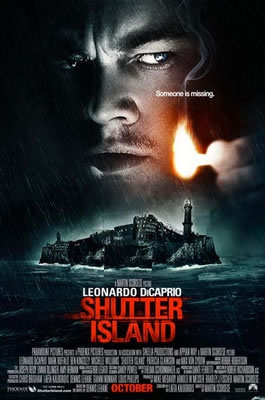 “It’s all about you,” comes the mysterious whisper. “Run” is the word, scrawled on a notepad, and shoved across the desk. Are these messages for Federal Marshall Teddy Daniels, sent to the mental institution on Shutter Island in order to locate an escaped convict? Or are they, actually, for Leonardo DiCaprio? It isn’t much of a giveaway to say that all is not as it seems on the eponymous island and that, perhaps, Teddy Daniels might be being taken for a ride. But it’s even less of a giveaway to say that – after having watched about ten minutes of the miscast DiCaprio weasel his way around his role – perhaps he’s the one being exploited. Director Martin Scorsese, it seems, loves to put Leo through the wringer. At times, Shutter Island seems like an elaborate experiment, in which Scorsese can make his ratty test-subject run through the maze. Still, whether he’s crazy as Howard Hughes, or crazier as Teddy Daniels, DiCaprio has really perfected that slightly pained expression. It’s even worked into the plot here: apparently Daniels suffers from migraines. Was there ever a better match for character and performer?
“It’s all about you,” comes the mysterious whisper. “Run” is the word, scrawled on a notepad, and shoved across the desk. Are these messages for Federal Marshall Teddy Daniels, sent to the mental institution on Shutter Island in order to locate an escaped convict? Or are they, actually, for Leonardo DiCaprio? It isn’t much of a giveaway to say that all is not as it seems on the eponymous island and that, perhaps, Teddy Daniels might be being taken for a ride. But it’s even less of a giveaway to say that – after having watched about ten minutes of the miscast DiCaprio weasel his way around his role – perhaps he’s the one being exploited. Director Martin Scorsese, it seems, loves to put Leo through the wringer. At times, Shutter Island seems like an elaborate experiment, in which Scorsese can make his ratty test-subject run through the maze. Still, whether he’s crazy as Howard Hughes, or crazier as Teddy Daniels, DiCaprio has really perfected that slightly pained expression. It’s even worked into the plot here: apparently Daniels suffers from migraines. Was there ever a better match for character and performer?
Well, yes. Before DiCaprio and Scorsese a raft of other duos were considered for Shutter Island. These included the Se7en pairing of David Fincher and Brad Pitt who, quite probably, would have turned out a much more convincing final piece. Because Shutter Island is made up out of a lot of great elements (no mention, though, of the script, which seeps exposition from every pore) that don’t really add up. And that’s mainly because of Marty.
Scorsese’s press junket script (Film 2010, The Culture Show, The Sunday Times…) has been largely comprised of him singing the praises of the old noirs and Hollywood thrillers that he’s plundered for Shutter Island. And, indeed, we’re served with ample helpings of Vertigo and Out of the Past. These are great touchstones, and nobody can begrudge Scorsese for turning to them for inspiration. Where else but the cinema should he go to for help with such a hair-pullingly contrived scenario? But while Scorsese constructs several interesting situations that clearly hark back to these movies, at no point does he relinquish his typical Scorsese-ness. The freeze frames, whip-pans, tracking shots and cutaways that made Goodfellas and Taxi Driver so unique here feel like techniques far too sophisticated for the material. By relinquishing the language of the 1940s and 1950s and turning, instead, to his old tactics, Scorsese turns Shutter Island into a paper tiger – all show and no claws. This demonstrates, if nothing else, supremely poor judgement on his part. Say what you will about Indiana Jones and the Kingdom of the Crystal Skull (please), but at least there, Spielberg managed to swallow his pride and shoot pulp as it was meant to be shot. Why can’t Scorsese do the same here?
This isn’t to say that the bombastic style and even the film itself aren’t, in places, fun. It’s just that Scorsese has clearly taken on a shoddy script and done his best. Except that, in this case, even with a director who still clearly has some clout, his best isn’t good enough. Even his regular editor Thelma Schoonmaker (who comes close here to saving the day – as per usual) can’t quite help.
Yes, the script is baggy and the performances are incoherent (Max Von Sydow and Ben Kingsley seem, clearly, to have decided early on that ‘fun’ is the best way to play it, but neither really justify their appearances – Von Sydow’s character could go entirely without upsetting the movie’s balance). What’s to be done? Scorsese is a man of infinite interests and Shutter Island is – thankfully – seemingly only a side-project, if not just hack-work. Watch for the George Harrison documentary, watch for the Sinatra biopic. Marty’s far from ready to quit.

